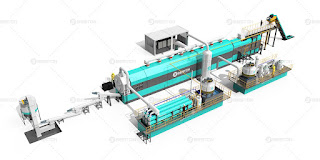Just What Is A Continuous Tyre Pyrolysis Plant?
Continuous tyre pyrolysis plants are used to process waste tyre into carbon black and fuel oil. These plants typically include a pretreatment system, a continuous pyrolysis system in addition to a continuous discharge and feeding system controlled by a PLC system. The primary part of these plants may be the pyrolysis system.
Considering that the feeding and also the discharge method is continuous, this kind of continuous tyre pyrolysis plant is able to work non-stop or twenty-four hours a day which helps to save energy and time. At the same time, the PLC control system results in far fewer labor costs.
Raw Materials
The raw materials utilized in a continuous waste tyre pyrolysis plant include a variety of different waste tyres derived from commercial and industrial sectors. The most prevalent waste materials include motorcycle tyres, bicycle tyres, OTR tyres, inner tubes, rubber overshoes, rubber hoses, truck tyres, car tyres, and much more.
Working Process
To preserve ongoing feeding and discharging, the waste tyres really need to be small in proportion. So just before the pyrolysis process can commence, materials are first shredded into smaller and more manageable pieces. Here are more information associated with this process:
- Collect Waste Tyres
Waste tyres can be bought in many shapes and forms from large OTR tyres to smaller car tyres. More information on waste tyre pyrolysis plant here.
- Shred Tyres
A specialized shredder is used to process the tyres into 3 to 5cm pieces. This product is a fully automatic shredder that connects straight to the feeder. This step does away with being forced to transfer the materials to the reactor.
- Feeding
By way of a sealed unique feed-system, the divided tyres are then fed directly into a pyrolysis reactor which achieves a sustainable feeding process.
- Heating And Continous Pyrolysis Process
The pyrolysis reactor is heated by natural gas, LPG, or fuel oil. Through these heating processes, the reactor rotates 360 degrees, to ensure the tyre waste is uniformly heated. After the temperature reaches around 300℃, the tyres crack and break up into oil gas.
- Cooling
The oil gas then flows in a 3-stage condensing system, where the gas cools down. The liquid oil produced through this method is going to be collected and kept in an oil tank. The leftover non-condensable gas is then accustomed to heat the pyrolysis reactor or stored. Get a portable pyrolysis machine here.
- Discharge
Carbon black is additionally produced in this method. This product is discharged through a slag-discharge system. This product is sealed, so that it is eco friendly.
Final Products Of The Continuous Tyre Pyrolysis Plant
- Pyrolysis Oil
The pyrolysis oil is either sold directly or reprocessed into gasoline and diesel via waste-oil distillation equipment. Pyrolysis oil can also be useful as being an industrial fuel material for burning.
- Carbon Black
Carbon black is additionally sold directly or reprocessed into high-quality carbon via a carbon-black processing machine. Carbon black is likewise used to produce carbon bricks. Check the small pyrolysis plant here.
- Steel Wire
Steel wire extracted from the waste tyres are widely used to make iron or steel rods or reprocessed for other uses.
- Combustible Gas
The combustible gas produced with the pyrolysis process is recycled and after that used as fuel to handle on providing a way to obtain heat on the reactor.


Comments
Post a Comment